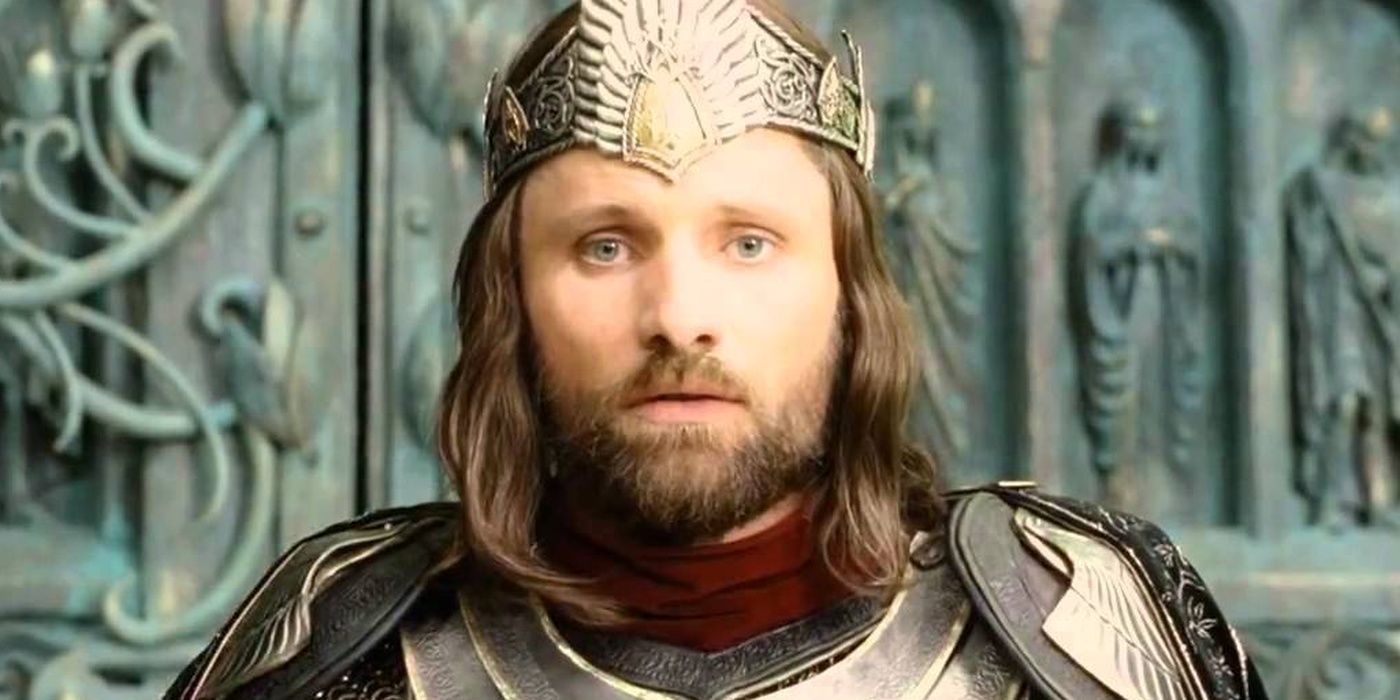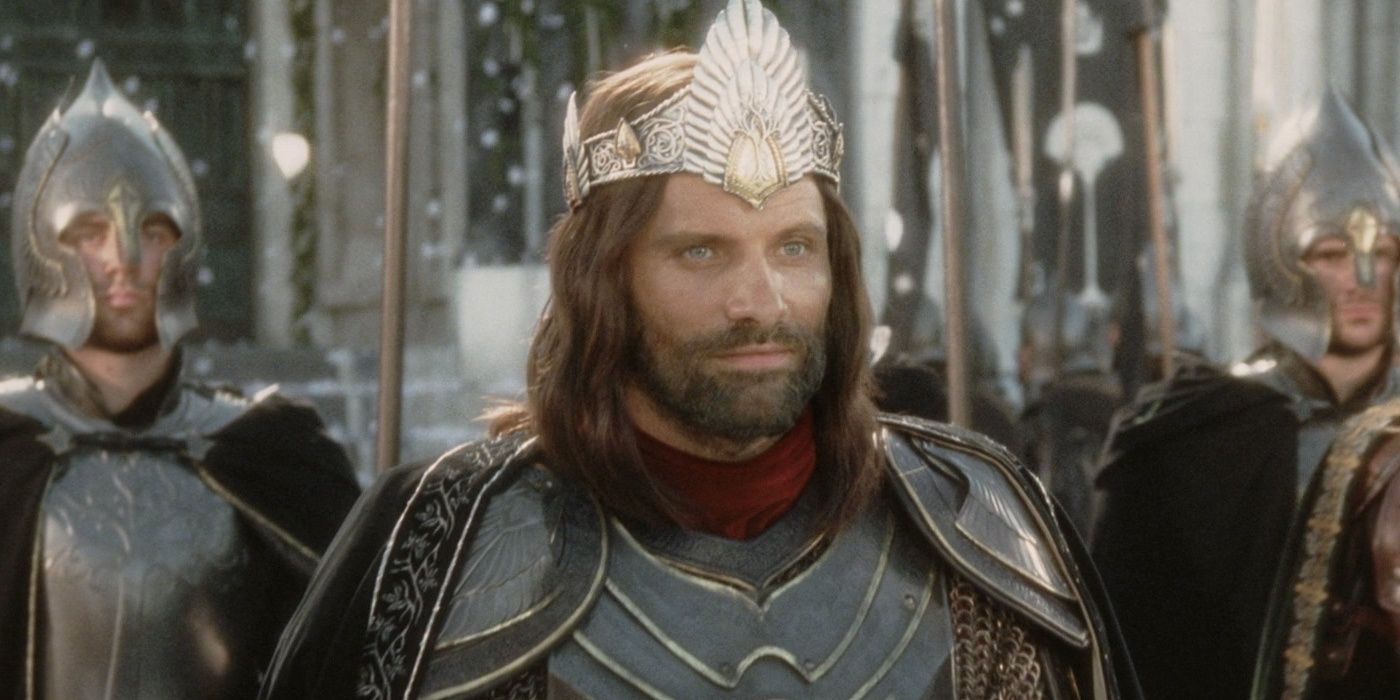At the end of the Lord of the Rings movies and the books, Aragorn (Viggo Mortensen) becomes King of the reunited kingdoms of Gondor and Arnor. Gondor is well known to most Lord of the Rings fans, but Arnor is overlooked. Some might not even know where Arnor is or what happened to this kingdom before Aragorn claimed the throne. This is most likely because Gondor is still around during the War of the Ring, yet Arnor isn't. So what happened to Arnor? Why did Gondor survive, yet Arnor didn't?
These questions might haunt Lord of the Rings fans, but luckily there are answers in the books. The Lord of the Rings movies do not go deep into the history of Arnor as the books do. Yet Aragorn technically claims the throne of both kingdoms at the end of the Lord of the Rings films. And there are aspects of Arnor mentioned in the films, even though its history is not discussed much.
To find and understand the answers to these questions, Lord of the Rings fans must know the history of Arnor and Gondor – as they're related. Arnor is located in the Northern part of Middle-Earth. The kingdom takes up most of the land of Eriador. It goes from the Gulf of Lune on one side to the river Greyflood and its tributary, Loudwater, near Rivendell. Once, Elves also lived near the Gulf of Lune, which they called Lhûn, in a place known as Lindon. Gil-galad, the High King of the Noldor, ruled over the elves of Lindon.
During the fall of Númenór, Elendil and his people sailed through the Gulf of Lune and befriended Gil-galad and his people. The people already living in Eriador welcomed Elendil and his sons, especially those who already had Númenórean blood. They helped Elendil as he started the new kingdom, Arnor, as did Gil-galad. Gil-galad even built three towers on top of hills for Elendil. They were known as the Emyn Beraid. Elendil officially started the kingdom of Arnor near the end of the Second Age, in the year 3320, while his sons started the kingdom of Gondor to the south.
Elendil established the capital of Arnor, Annúminas. Mostly, Elendil's subjects lived in places like the capital, Annúminas, Fornost, and smaller places like Bree, which Frodo passes through during the events of Lord of the Rings, and was a part of the kingdom of Arnor. During the Second Age, in the year 3430, Arnor joined forces with Gil-galad and his people to oppose Sauron. This alliance was known as the Last Alliance of Elves and Men.
The War of the Last Alliance lasted for quite a while, and Gondor also got involved. Unfortunately, the High King Elendil and his son Anárion perished in battle. Luckily, the forces of Elves and Men did win a victory against Sauron due to Elendil's older son Isildur, who cut the One Ring off of Sauron's hand. Isildur also was Elendil's heir and would inherit the throne of Arnor. However, he never got there. Along with three of his sons, he perished in the Disaster of the Gladden Fields, where the One Ring was lost. Isildur's youngest son Valandil became his heir, but he claimed only the throne of Arnor, and neither he nor most of his heirs claimed the throne of Gondor. And the kingdom had suffered so many losses during the War and the Disaster, which it never truly recovered from.
Arnor, unfortunately, had more to go through in the Lord of the Rings universe. During the Third Age, in the year 861, Fornost Erain took Annúminas' place as the capital of Arnor. Annúminas was then slowly left behind by Arnor's inhabitants. Also, in 861, Arnor's King Eärendur passed away, and his three sons all wanted to rule. The oldest son, Amlaith, tried to claim the throne of all of Arnor, but he eventually had to be content with ruling over just the area of Arthedain. At the same time, the other two sons of Eärendur formed the kingdoms of Cardolan and Rhudaur. The three kingdoms often fought due to control over the Weather Hills and the palantír at Amon Sûl.
An enemy of Arnor and Gondor would see this lack of unity and take advantage of it. During the Third Age, in 1300, during the reign of Malvegil in Arthedain, the Witch-king of Angmar, the leader of Sauron's Nazgûl, began attacking Rhudaur and Cardolan. Eventually, one of the Hill-men would take over Rhudaur and ally with Angmar. At that point, there were few Dúnedain left in Rhudaur. The seventh King of Arthedain, Argeleb I, would attempt to refound Arnor but was unsuccessful due to Rhudaur resisting. However, he would reunite Cardolan and Arthedain. Unfortunately, he was slain in the year 1356 of the Third Age.
His son, Arveleg I, did well against Angmar and Rhudaur until the year 1409 of the Third Age when Weathertop was captured, and Arveleg himself perished, along with the last prince of Cardolan. Amon Sûl fell, and its palantír was taken to Fornost. The Witch-King then had control of all of Cardolan, forcing the population to flee to the Old Forest or hide in the Barrow Downs. Evil Men, who supported the Witch-King of Angmar, moved into the area, and the remaining Dúnedain were either destroyed or forced to flee west. By this point, the men of Arnor were not strong enough to defeat Angmar alone. So the elves of Lindon, Rivendell, and the Galadhrim would help out.
A plague came to Arnor, which the Witch-King also exploited. After the demise of the last Dúnedain of Cardolan, on the Barrow-downs, the Witch-King would send evil spirits known as Barrow-wights to the area. Arnor and Gondor eventually suspected that one force might be behind all of this misery and began communicating with each other again. During the Third Age, in the year 1940, the heir to the throne of Arnor, Prince Arvedui, would wed the daughter of the King of Gondor. Arvedui, after the demise of his father-in-law, would attempt to claim the throne of Gondor as well, through both his descent from Elendil and through his wife. He was unsuccessful. Arnor became weaker and weaker, and during the Third Age, in the year 1974, the Witch-King attacked the capital of Fornost and took it over. Arvedui, now king, fled to Forochel, and his son Aranarth informed Círdan about the tragedy. Unfortunately, Círdan's sailors could not save Arvedui, and he would be the last king of Arthedain.
The remaining forces of Arnor would join with the forces of Gondor and Círdan's forces to attack the Witch-King. The Witch-King's forces would eventually fall, with some help from the forces of Glorfindel from Rivendell. However, the Witch-King himself would escape. The remaining Dúnedain from Arnor would make a new home in the Angle south of Rivendell. Aranarth became a Chieftain instead of a king, as he did not have enough people to reestablish Arnor. The heirlooms of the House of Isildur, such as the Sceptre of Annúminas and the Ring of Barahir, were given to Elrond. Elrond also raised Aranarth's son, Arahael, and that tradition would continue for the rest of the Third Age.
So why did Arnor fall while Gondor survived? Most likely, it's due to the breaking up of Arnor's kingdom and the instability and civil war, which the Witch-King exploited. Add a plague and many many kings fallen in battle; it makes sense that Arnor did not last. On the other hand, Gondor had one king after another and the Stewards, so there was more stability in that kingdom than in Arnor. Also, from the beginning, Arnor had a smaller population than Gondor and was not nearly as powerful, despite being where the High King ruled. However, the story does have a somewhat happy ending. Aragorn reestablishes Arnor at the end of Lord of the Rings and reunites it with Gondor. So perhaps all is well in Middle Earth in the end.







